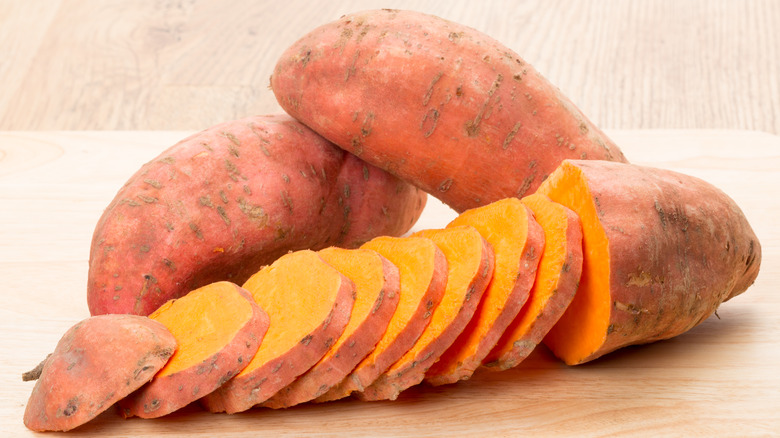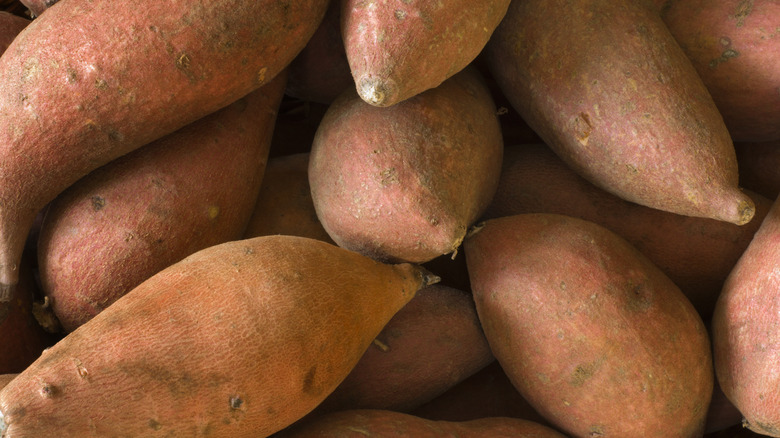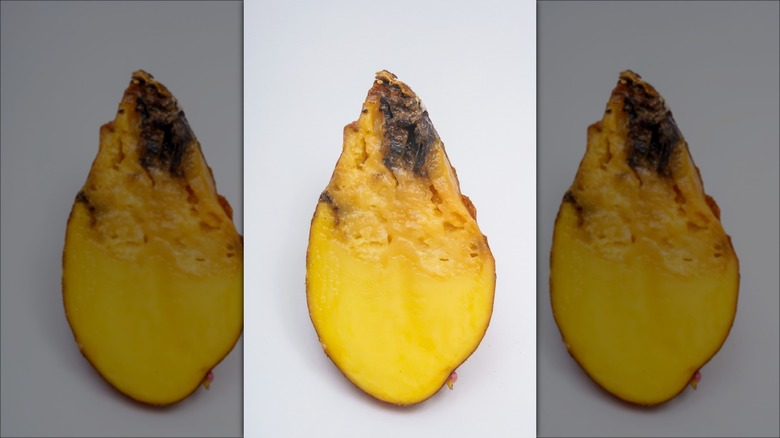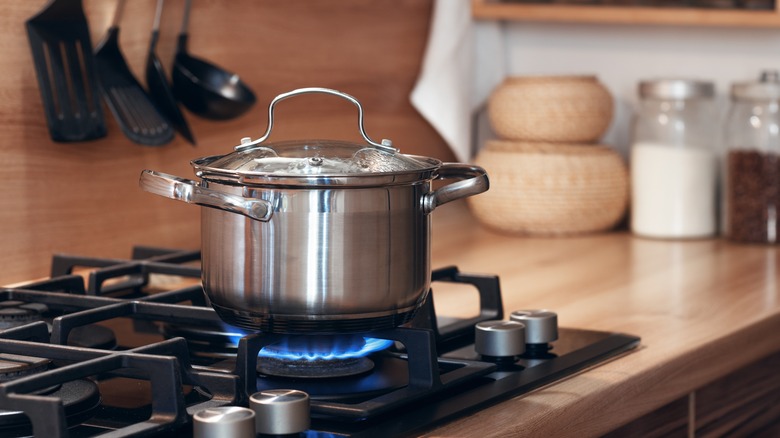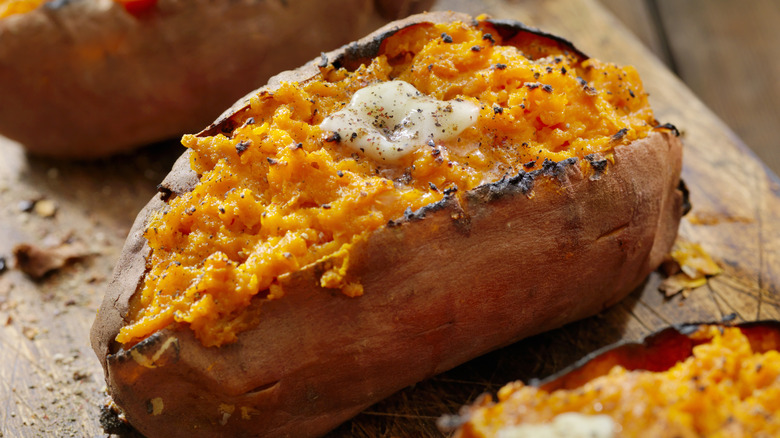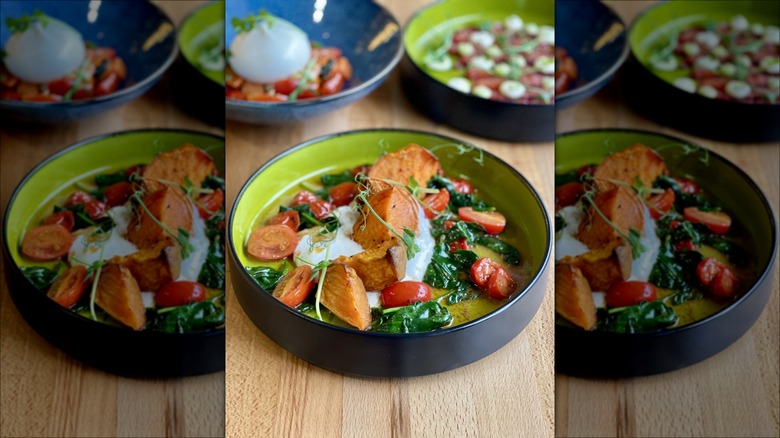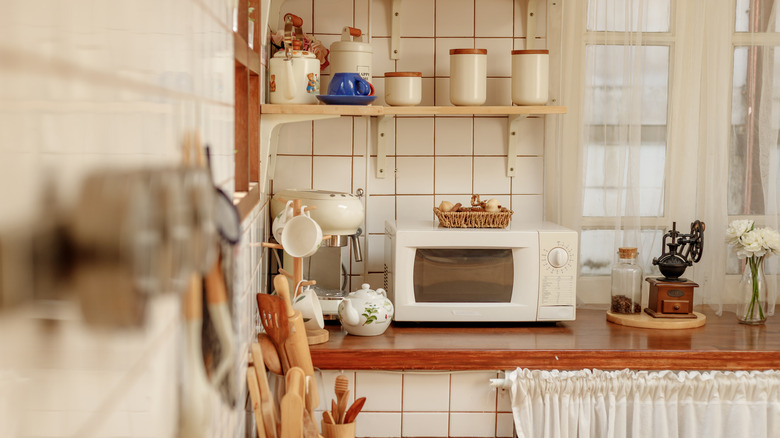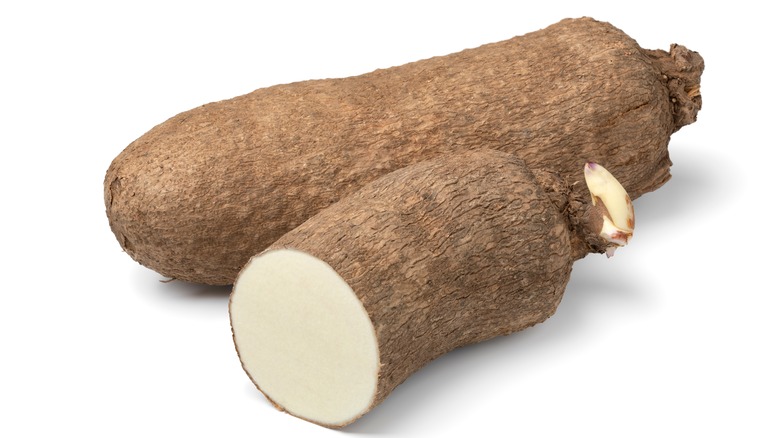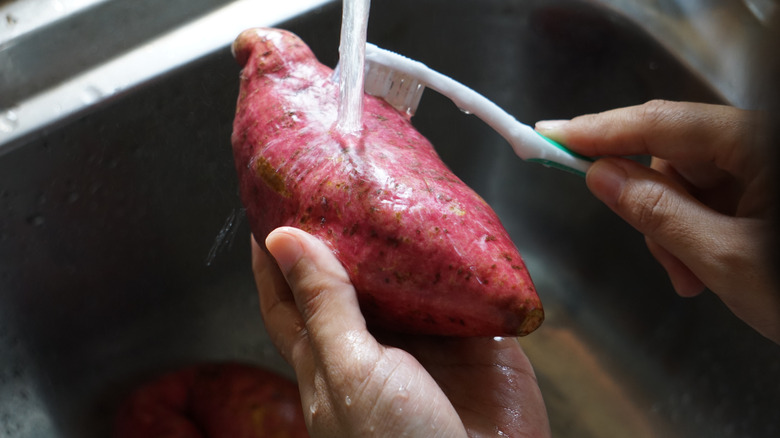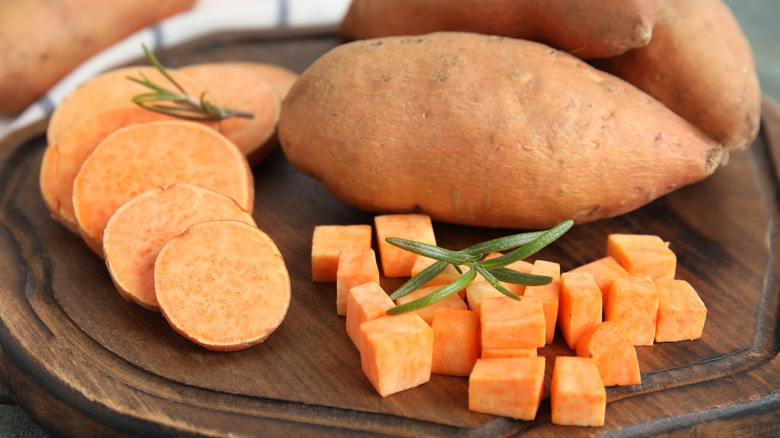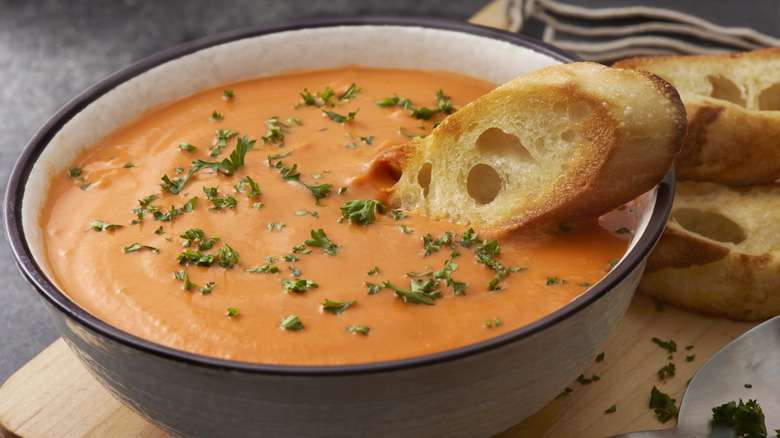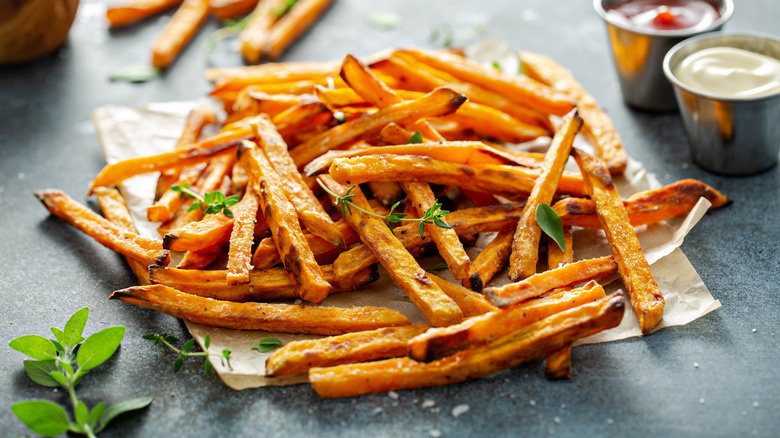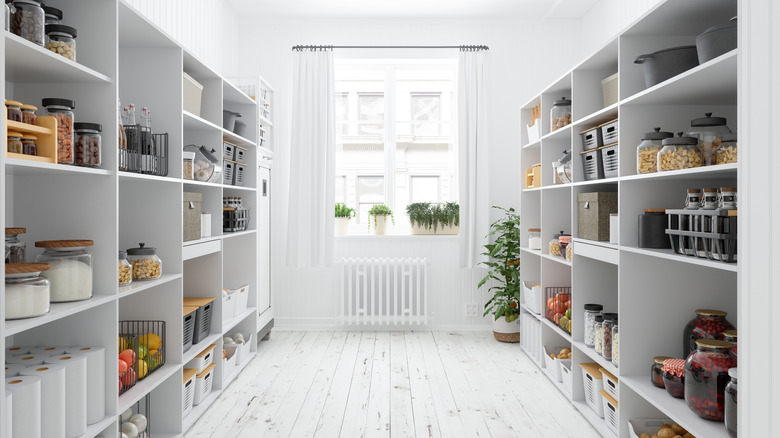Mistakes Everyone Makes When Cooking Sweet Potatoes
Sweet potatoes have enamored human taste buds for thousands of years. The first known sweet tater eaters can be traced back to Peru, where the root vegetables have been grown since about 750 B.C. Despite the centuries that humans have had to perfect the cooking of their sweet spuds, there are still plenty of things that mankind gets wrong when rocking up to the stove to cook them. Sometimes, these errors merely result in sweet potatoes that taste good but not as great as they possibly can be. However, in some cases ' such as when home chefs are dealing with that sweet potato counterfeit, the yam — toxic poisoning and even death can ensue.
Fortunately, many of the most common mistakes that food nerds make when they're cooking sweet potatoes are easily corrected, sometimes with moves as simple as changing the way that the potatoes get cut. For the dangers that are more difficult to navigate, knowing what's what in the sweet tater world helps a lot. To that end, this article teaches you some of the most common ways that home gourmands mess up a perfectly good sweet potato. You'll also get some ideas on how to correct some of these mistakes, too.
Leaving uncooked, whole sweet potatoes in the fridge
With their rough skins and firm textures, it's easy to forget that sweet potatoes do go bad eventually, which means if you bring some home, you need to stash them someplace that allows you to preserve them. If your first thought was the fridge, you may want to rethink that plan. The fridge turns the center of your sweet potatoes into edible white rocks, more or less, and in turn, changes the flavor from natural candy to something you'll want to spit out.
Eating them is possible after they've been in the fridge, but it's unlikely you'll enjoy them much. And you're not just imagining the structure and taste changes that come along with fridge storage. The frigid cold of the refrigerator changes sweet potatoes on a cellular level, much like gamma radiation changed Bruce Banner into the Hulk. He ain't never going back to what he was before. Neither are your sweet potatoes.
So what's a sweet potato lover to do? Being a root vegetable, sweet potatoes like to sleep in cool, dark places, not cold as the fridge cool, but cool, nonetheless. Aim for 50 F to 60 F here. In light of that, putting them in a basket on the floor in the pantry, for example, keeps them away from the heat of the stove and in the dark where they'll sleep peacefully for a month or two until it's time to eat them.
Buying sweet potatoes that might be bad
Fortunately, you'll never have to find out that your sweet nuggets are bad because you've just bitten into one. Bad sweet potatoes leave plenty of visual, olfactory, and tactile clues that should prevent you from tainting your taste buds with a mistaken bite.
Since the visual and tactile signs of badness often catch the attention first, it's a good place to start. Bad sweet potatoes look and feel a bit wrinkled and mushy. Mold may have taken up residence. Dark spots of black, gray, and even green may mar the skin and the interior. They may have also begun to sprout eyes. Only in this last case do you really have some leeway. If the sprouts are isolated to one small spot that you can cut off and the rest of the sweet potato seems good, the sweet potato is still edible. But if it's also mushy and has mold spots and the colors of the dark rainbow, toss it. However, ideally, particularly when you're out shopping for them, the appearance of the sweet potatoes you buy falls into the evenly colored, firm-looking, and ready-to-eat category.
Finally, the smell of a sweet potato also indicates its freshness. By the time it goes really bad, you won't need to touch it or even see it. Your nose will find its presence before your eyes do.
Boiling sweet potatoes for certain recipes
Recipes like sweet potato pie call for softened sweet potatoes. To satisfy this requirement, many home gourmands get a pot boiling in order to prepare the potatoes for pie. While this isn't technically wrong for recipes like sweet potato pie, the taste of such recipes is better served if the sweet taters get a pass in the oven instead. Roasting or baking is fine. This is one of those instances where food chemistry plays a role in the taste of your recipes. The sugars inside the sweet potato are liberated by the enzyme amylase and turn into caramelized goodness in the oven. This jacks up the sweet factor even if you don't add any sugar.
There is a caveat to all of this, of course. The enzyme must get the slow-release treatment to start this chain reaction. Roasting or baking the sweet potatoes in the oven does this in a way that boiling your sweet potatoes won't. Incidentally, this is also the key to ensuring that your sweet potato dishes don't get too sweet. That is to say, recipes like sweet potato pie that call for more sweetness do better if the sweet potatoes are baked or roasted. However, for a casserole that should be both sweet and savory, boiling may be a better option. It slows down the release of the sugars inside the sweet spuds, thus toning down the sweetness.
Not taking proper care when baking them
Baking sweet potatoes shouldn't be difficult, right? Well, yes and no. If you've ever compared the density of a sweet potato to that of a regular potato, you'd notice right away that sweet potatoes have a density that your garden-variety spud doesn't. The sweet potato requires plenty of time in the oven at about 375 F to ensure that you don't break a tooth on your baked sweet potato come dinner time. How long it takes to bake your sweet potato varies, depending on the size of the potato. It could be 30 minutes to just over an hour in the oven before it's done.
And what's the best way to tell if it's done? If it passes the fork or knife test, you're golden. That is if you can stick a fork or knife into the potato, and it slides in easily, and the interior feels mushy, it's ready to eat. Often this method beats the timer for accuracy.
To start, scrub the potato with a vegetable brush until all the grime has been removed. Some home chefs pierce the skin of the sweet potato with a fork to ensure that it doesn't blow apart in the oven. (No, we're not making that up.) However, there's a reason why you shouldn't pierce holes in your sweet potato before baking. All the sweet sugars that baking brings forth get pulverized when the steam escapes the sweet potato through the holes, making it less sweet.
Thinking they're only good for sweet dishes
With sweet potatoes being naturally as sweet as a cookie, it's tempting to think that they're only good in sweet dishes like pie. This isn't the case. In the world of taste, few things bring out the savoriness of meats or roasted vegetables quite sweetness. In traditionally spicy recipes, like chili, for example, sugar added to the meat and the stewed tomatoes balances the tomatoes' acids. But for those looking for some kind of off-the-wall ingredients to add to their favorite chili recipes, sweet potatoes are a better, more interesting choice for this normally savory and spicy dish. They possess the sugar content to cut the tomatoes' acidic nature but are more flavorful, better for you, and bulkier to boot.
But this isn't the only place where sweet potato plus savory equals delish. Mashed sweet potatoes doctored up with some olive oil, garlic, white pepper, and Parmesan give your average mashed potatoes recipe a run for their money. Sweet potatoes are often popular additions to savory Asian soups, morning hash, or as a side to steak. And if you want to take part in a memorable potato bar, try including some baked sweet potatoes in the mix, and you'll see just how out of this world they taste topped with a bit of broccoli, feta cheese, and black beans. Sweet and savory is the new sexy, and the sweet potato is the food nerd pin-up du jour.
Avoiding the microwave
For the food snob, the microwave is a thing of contempt. For the food desperate, it's the speediest route to dinner when you're two hours into the hangries. But microwaves don't deserve the bad rap they sometimes get. Case in point? The microwaved sweet potato. Many people shy away from cooking their sweet potato in the microwave because they believe that it destroys the spud's nutrients. The fear is valid. It's a lot of nutrients to lose, given that it's a source of vitamin A, vitamin B6, folate, and vitamin C, as well as being a fat-free source of fiber.
As it turns out, microwaving your sweet potato preserves these nutrients in the same way that baking the sweet spud would. Boiling or steaming the same nugget of sweetness means a 20% to 30% loss of vital nutrients, including vitamin C. Further, the microwave's speed of cooking ensures that it keeps even more of its nutrients, more than if the same item were to be cooked slowly, for example.
Microwaved sweet potatoes can take between five and 15 minutes to cook, though it can be difficult to determine the exact cooking time due to the varying sizes of the sweet potatoes. To cook them in the micro-burner, scrub them and prep them as you would a baked sweet potato. Put in the microwave to cook. They're done when a fork goes all the way through them easily.
Substituting yams for sweet potatoes in dishes
The substitution of yams for sweet potatoes might be the greatest attempted currency exchange in the vegetable kingdom. However, like most currency exchanges, there really isn't a one-to-one equivalent, despite what people think, which means that home chefs get short-changed if they try to use yams in recipes that call for sweet potatoes. They belong to two different families in the vegetable kingdom, with yams being from the lily family and sweet taters being kin of the morning glory.
For the untrained eye, the two sort of look alike in the same way that one glance at sweet potatoes and regular potatoes tells you that they're both root vegetables, even if they're not exactly alike. It's their similarities plus decades of mislabeling that are responsible for people believing that raw sweet potatoes are toxic. They aren't, but yams can be.
Aside from possibly having the ability to poison you in the right conditions, yams don't have the flavor profile nor the texture of sweet potatoes. Compared to the strong, sweet flavor of the sweet potato, eating a yam is a lot like eating a mouthful of starch with zero flavor unless you add copious amounts of butter, oil, and your seasonings of choice. You're also more likely to find sweet potatoes than yams in U.S. grocery stores. As for those candied yams you eat every Thanksgiving? They're usually sweet potatoes that wear the wrong label, an example of this attempted foodie exchange playing out in real time.
Foregoing washing before cooking
Sweet potato skins, and the meaty area of the sweet spud hiding just underneath the skin, pack a power punch when it comes to nutrients. By eating the skin, you've given yourself a big dose of vitamin A, as well as C and E. You'll also enjoy an infusion of manganese and potassium. And fiber? Forget about it! There's plenty of it in the skins. Therefore, if you're planning on chowing down on the sweet potato skin, it should be as clean as a root vegetable's skin can be. Otherwise, with each bite comes bits of dirt and grime instead of the taste-bud sweet treat that it should be.
To ensure that you'll get all the dirty clingers that hang on to the sweet spud's skin, wash the sweet potato under a stream of running water. The Centers for Disease Control (CDC) advises against using dish soap or detergent to remove germs and grime from sweet potato skin. If you feel that washing your fruits and veggies in something besides water is a must, try baking soda or vinegar instead. To ensure extra cleanliness, use a veggie brush or a toothbrush to get the grime out of the little nooks and crannies on the skin.
Not using sweet potatoes as a gluten-free substitute
Pop quiz for you. When are sweet potatoes not sweet potatoes? When they're bread, that's when. In all seriousness, for many people, eating bread is not only a guilty pleasure but represents a staple in the diet. It's a cornerstone for sandwiches, a dipping apparatus for the last of your gravy at dinner, and a traditional food item that's expected to accompany meals as mundane as supper and as elaborate as Thanksgiving. However, for those who cannot eat gluten, bread is a forbidden item, a no-no that once upon a time, before gluten-free status, was a yes-yes. Finding something to replace it represents a major frustration for those who are gluten intolerant.
Aside from the inconvenience, much of the frustration stems from the fact that bread does play such a significant role in meals like lunch. Additionally, gluten-free offerings of bread (or pasta) are also cost-prohibitive for many, with some gluten-free bread offerings costing nearly $8 a loaf. However, foods like sandwiches and toast get new life when you use sweet potato as a substitute. In its simplest form, it's just sliced sweet potato that is baked until the outside turns crispy and toast-like. More elaborate gluten-free recipes are made with sweet potato flour instead of regular flour. Sweet potatoes are the gluten-free substitute that you never knew you needed until today. You're welcome.
Forgetting to use them as a soup thickener
What if we told you that there was a common item that you could put in your tomato soup that would not only thicken it nicely but also cut the tomato's acid factor in half? Would you search high and low for this elusive ingredient? The good news is you don't have to. You just need to take a trip to the produce aisle in your grocery store and pick up a couple of sweet potatoes.
For those who are soup chefs at home, you probably know very well that some sort of starch, often in the form of a roux or even a slice of bread, is what you need to thicken up your soup. While those are still viable options, they're not the only ones. Sweet potato as a thickener gives you the starch factor that you need to get thick, creamy soup every time, but it also adds flavor that can be missing from other more standard soup thickeners.
All you need to do to employ this trick is to boil or bake your sweet potatoes until they're soft. Peel off the skin, and then toss them in the blender, and puree them until they're smooth. Once you have this puree, stir it into your soup. That's it. Incidentally, instant mashed potatoes work great in this capacity, too.
Learning only a few ways to chop or cut them
It should be stated up front that no actual rule exists that forces you to cut up sweet potatoes in a certain way. That said, there is an argument for learning how to do so. Once you have mastered cutting or chopping your sweet potatoes, you know how to cook them more thoroughly and efficiently. For example, dicing your sweet potatoes into smaller bits makes them easier to roast. Think of it this way. It's easier for the oven's heat to penetrate a half-inch by half-inch cube versus a whole sweet potato.
Some of the most common ways to slice sweet potatoes include wedges, diced, rounds, or fries. After you wash and prep the potatoes, use a very sharp chef's knife to cut off the ends of the sweet potato. If you're not planning on eating the skins, you'll want to peel the sweet potatoes at this time too. Take care when you're slicing the potatoes, keeping them steady with your non-cutting hand. Create slices that are as uniformly sized as possible. Aside from looking better, this allows them to cook more evenly. Once you have cut your sweet potatoes, use them to create the best sweet potato recipes this side of foodie heaven.
Creating a pantry without canned sweet potatoes
Canned goods play a huge role in the setup of your emergency food pantry. While there are the usual suspects like canned corn, tuna, okra, and black beans, you might be leaving an important pantry staple off your list if you don't include canned sweet potatoes. Granted, many people keep fresh sweet potatoes in their pantry. However, although those last a long time, the months that they might last don't compare to the years that their canned counterparts do.
As far as how to use them, they often work well as substitutes for recipes that call for fresh sweet potatoes. Sweet potato pie, sweet potato casserole, and sweet potato hash count among the ways you can use canned sweet potatoes. As for the number of them, a good rule of thumb for emergencies is to keep enough canned goods of each type in your pantry so that you have enough to provide you with two-and-a-half cups of vegetables a day.
